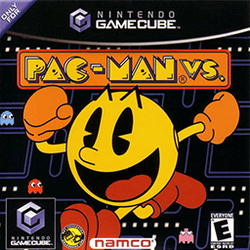Pac-Man Vs.
| Pac-Man Vs. | |
|---|---|
 North American GameCube cover art | |
| Developer(s) | Nintendo EAD |
| Publisher(s) | Namco |
| Platform(s) |
GameCube Nintendo DS Mobile phones |
| Release date(s) | |
| Genre(s) | Maze |
| Mode(s) | Multiplayer |
Pac-Man Vs. (パックマンvs. Pakkuman Buiesu) is a video game in the Pac-Man series developed by Nintendo and published by Namco for the GameCube. It was originally included as an extra bonus disc with the Player's Choice edition of Pac-Man World 2, as well as in the GameCube versions of I-Ninja and Namco's R: Racing Evolution. The Japanese version was originally released only for the Club Nintendo members.
The game itself takes advantage of the GameCube's connectivity with the Game Boy Advance (GBA), and cannot be played without the Game Boy Advance and the link cable to hook it up to the GameCube. It is one of a few select GameCube games designed around the system link, including Final Fantasy Crystal Chronicles and The Legend of Zelda: Four Swords Adventures. It is one of the earliest examples of asymmetric gameplay from a Nintendo game, about nine years before the release of the Wii U and its bundled Wii U GamePad, which is marketed as a tool designed to allow this kind of gameplay.[1]
The game is included in the Namco Museum DS game collection and supports single-cartridge multiplayer. Also, Pac-Man Vs. is available in Japan on mobile phones and is played with bluetooth. The game also runs on Nintendo's Wii, when using original GameCube controllers and a GameCube connection cable.
Gameplay
The gameplay uses the GBA in a unique fashion. One player controls Pac-Man with the GBA, which displays the entire maze, while the other players control each of the Ghosts with the Gamecube Controller. The game cannot be played as a one-player game. One player must be Pac-Man, and at least one more must be a Ghost.
Pac-Man's goal is to eat all of the pellets on the game board while avoiding being tagged by the Ghosts. The Ghosts' goal is to catch Pac-Man, merely by touching him. These players each see a 3D-rendered limited view of the surroundings of their own Ghosts on the television screen as well as the area around the other players' Ghosts, since they are all displayed on the same screen. Ghost players can temporarily extend their view by eating fruit. If a Ghost player catches Pac-Man, the two players switch controllers, with the successful Ghost player taking the GBA and playing as Pac-Man until he or she suffers the same fate of being caught. A small radar helps show the ghosts their relative positions to each other so they may attempt to team up to trap Pac-Man. Once there are less than 25 Pellets left on screen, they become invisible to the Ghosts.
If there are fewer than four players, any uncontrolled Ghosts start grey and are harmless to Pac-Man. However, a Ghost player can touch a gray Ghost and tag it with his or her own color. If a computer-controlled colored Ghost touches Pac-Man, it kills him and counts toward its owner’s score.
The first player to reach a predetermined score of 7,000, 10,000, or 15,000 points wins, and the game ends. While both Pac-Man and the Ghosts can score points by eating fruit, Pac-Man has the advantage of having more ways to score points. Pac-Man can score points by eating pellets on the board. For eating all the pellets on the board, Pac-Man receives a 1600-point bonus and gets to continue playing on a new board. If Pac-Man eats a Power Pellet, all of the Ghosts turn blue, and Pac-Man can eat them for bonus points (which, if possible, are subtracted from the eaten ghost's score). In addition, simply being Pac-Man is worth 1600 points, points which are lost and given to whichever player can catch Pac-Man.
There are several maps available, including the classic level from the original game. The classic stage retains a retro design and lacks any background music, but the remaining stages all have a theme to their design (Panic Pier appears to be made of Piers, for example) and a background song, most of which come from Pac-Mania. One of the songs is from Pac-Man Arrangement, which is from world 1 of that game. The map selection on the DS version only has five of the six Gamecube maps selectable; however the names and themes for each have been altered. The background music featured in the DS stages are remade songs and/or medleys from Pac-Mania, Pac & Pal, Thunder Ceptor, Dragon Spirit, and Libble Rabble.
Despite the different aesthetic appearances on the TV screen, all the stages look as if they were on the original game when viewed on the Game Boy Advance.
External links
References
- ↑ "Nintendo's Wii U Ushers in New Age of Video Games with Integrated Second-Screen Experience". Nintendo of America Inc. Retrieved 3 October 2012.